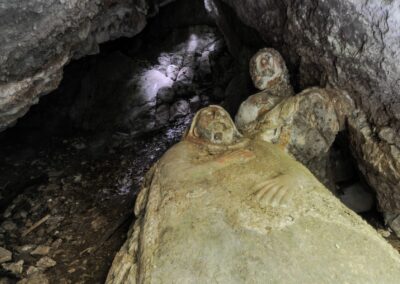Grotte di Maurizio
A hermit and his man-stone world
In the thick bush where the Casciani Creek has its source, a marked path leads into a secret world inhabited by stone-men.
One descends cautiously until reaching a gorge carved by the waters of the stream, and there, once one’s eyes get used to the darkness, a stone sarcophagus appears, a totem with human features, watched over by other concrete figures and a chorus of carved heads.
They look like remnants of an ancient civilization but come from the near past.
Their story is that of their creator, Maurizio Becherini, bricklayer like his father, barber and tailor, three children, widower. Upon the death of his wife, he retired from the Franciscans of San Vivaldo, where he lives a life of prayer interrupted from time to time by a visit home.
Then, the big leap, it’s 1918 and Becherini retires to a solitary life in this very ravine. In a little more than ten years he will tame the forest and carve stone, creating a sacred space. He built a small chapel and scattered the forest with walkways, statues, shrines, saints and Christian symbols.. He uses concrete, chicken wire as rebar, goes in search of shells, buttons and pebbles for minute details.
He occasionally goes to service in the countryside to raise two liras, sees his children, and welcomes walkers and pilgrims to visit him. The Church meanwhile seems to take no notice of the hermit and his sacred cave, but in 1928 Maurice stands up for a healer who is denied the sacrament of the Eucharist. It unleashes the fury of the bishop who treats him as the equal of a freak: “one such Maurice intended to erect a kind of holy cave, to worship the Holy Trinity, St. Peter, etc. there. represented by some absolutely grotesque and ludicrous statues he himself formed […] a destination for excursions by grievous and superstitious souls or mocking spirits.”
Four years later he died; it was 1932. Today, few traces of its world remain, vegetation has ingested its art, recaptured it, giving us evocative scenery, ruins of an entirely private archaeology.
Going in search of this marginal universe is like delving into the imagination of Maurice, the hermit and the visionary, who here, for 13 years knew how to live without any care for what was happening in the so-called normal world.
STARTING YOUR ITINERARY: FROM THE CENTRE OF GAMBASSI TERME
Starting from the centre of Gambassi – in front of the Cristo Re Church – you will take the part of the Via Francigena that goes from the village of Gambassi to San Gimignano. This road provides spectacular views of the Valdelsa, Certaldo and the famous towers of the “Medieval Manhattan”, San Gimignano.
Surrounded by vineyards and centuries-old oak groves, just after the Casanuova hamlet, take a path on the right that brings you to the valley floor of the Casciani torrent. After Santa Teresa, you reach the San Claudio farm. Following the Casciani, you quickly arrive to the Bollori.
To return to Gambassi, take the approach that connects directly to the village.
ALTERNATIVE ROUTE
An alternative path allows to trace back to Poggio alla Forra. deviating by trail n. 5, you can see the remains of the ancient aqueduct that channelled water from the spring of Botro delle Docce.
This old aqueduct, almost 5 kilometres long and inaugurated October 1st, 1908, was an especially important work for providing locals with drinking water.
Follow the Strada Volterrana to return to Gambassi.

